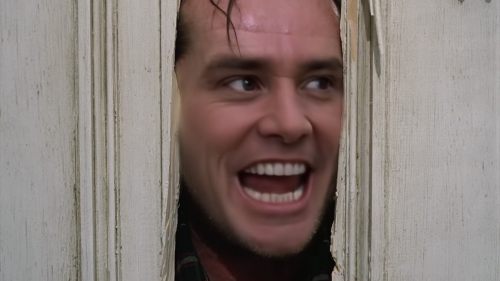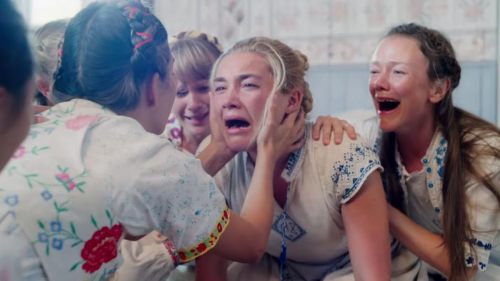Effects Artists Josh & Sierra Russell On The Best Way To Build A Dead Body
Chances are you’ve seen a horror film or TV show that has featured some of Josh and Sierra Russell’s work. A young, innovative special effects team with a plethora of iconic decapitated heads adorning the walls of their studio, the duo has worked hard on a myriad of recent indie pictures, including XX, Beyond the Gates, Sequence Break, Lowlife, The Devil’s Dolls, Southbound, and the upcoming David Bruckner creature flick The Ritual, along with Mickey Keating’s latest sadistic entry Psychopaths. Lately, they’ve been building fake cadavers for NCIS, crafting lifelike gutted neck pieces for Narcos, and occasionally sleeping when there’s a few hours to spare. I caught up with the pair during one of their rare days off, and was lucky enough to hear all about how they got involved in the business, who their personal favorite effects artists are, and the right way to make heads explode onscreen. Check out our chat below and learn a thing or two, just in case you suddenly find yourself in need of a convincing silicone corpse.
Birth.Movies.Death: Every horror fan has their own personal favorite special effects artist, but I would love to hear from two people who actually create makeup and special effects for a living who their choices are. Who inspires you? Who would you list as the most talented pioneers of your craft, and why?
Sierra Russell: Pretty much anything Dick Smith does is beautiful, so he’s like the Michelangelo, I would say like Rick Baker would be a Leonardo da Vinci who was very innovative with amazing things like the wolf transformation in An American Werewolf in London. The wheelbarrow wolf, he’s on a wheelbarrow and it’s just his front paws. I love it. Hellraiser, which was Bob Keen. Steve Johnson is my favorite aesthetically.
Josh Russell: Steve Johnson is my favorite technically. He comes up with the best implementation, the best new gimmick. You give him a problem and he can solve it. It’s what Tom Savini was good at, but Steve Johnson was just kind of the genius of that for effects work, like making monsters out of trash bags but making them look amazing.
Sierra Russell: Dick Smith is the godfather of effects to me. I always try to model my studio after his, but it’s nearly impossible with the way we run it. Savini is innovative, Rick Baker is not only innovative but pretty. Steve Johnson is my favorite also just because of his attitude.
Josh Russell: Steve Johnson has a fun personality. They all have their different merits. Dick Smith invented it all, Tom Savini took the innovation further - the work didn’t look perfect but he did some of the best stuff out of the eighties. Tom Savini and Rick Baker came up together. Rick Baker knew how to make everything perfect. Stan Winston knew how to make the business aspect run smoothly while delivering the best, uncompromised effects, and making some of the most iconic creatures that we’ve ever seen in film. Steve Johnson took the Tom Savini innovation to the next level and would come up with crazy solutions to impossible problems. Kevin Yagher seemed like the most well rounded dude that could do top notch work without letting it all go down the drain, he’s one of my favorites for sure, like The Crypt Keeper and Chucky. Jim Henson, of course is a legend. Mark Shostrom did a bunch of really cool effects work in the eighties. He did all the transformation effects in A Nightmare on Elm Street 2, with Freddy coming out of Jesse’s body up against the wall. From Beyond, all kinds of really good Cronenbergian body work stuff.
BMD: What about Greg Nicotero?
Sierra Russell: Nicotero is THE business guy.

BMD: Can you talk a little bit about your background and how you got into makeup and special effects in the first place? Were you two always passionate about practical effects and movie monsters?
Josh Russell: Ninja Turtles is what got me into this. It was like, just one of those things at a young age watching it, I knew that it wasn’t real, but they looked so incredible, they could emote, they looked like living creatures somehow, I mean what more do you need as a kid to capture your imagination? And then when the second movie came out, they released like a thirty second behind the scenes video tape that I wore out this VHS of that went into Jim Henson’s shop it showed how the animatronic puppets worked, what the guys looked like under the suits. I think the next year was when Jurassic Park came out, and it was pretty much a done deal. I used to sit up in my closet at night while my parents were asleep and look through this behind the scenes Jurassic Park book, look at all the pictures of the workshop, put towels under the door so the light wouldn’t come through, so they didn’t know I was awake reading.
Sierra Russell: I grew up on Planet of the Apes and all of the King Kong movies and they were mesmerizing to me, but later, it was pretty much Day of the Dead and just ripping a body in half and just wondering ‘How did they do it?’ Also magic was one of my favorite things as a kid, like David Copperfield. I used to watch him all the time because he was always on like weekly. It’s just one of those things where you know it’s not real but you don’t know how they do it, and the curiosity behind that. How does that happen? How do you tear a body in half?
BMD: Where do you two fall on the big practical effects versus computer generated images debate? What’s the key to properly using CGI in a film, and balancing the use of CGI with practical effects?
Josh Russell: Compositing is like the best use of CG, I think that’s what they’re most efficient at, where you’re taking two separate elements that are filmed, two or more separately filmed elements and combining them together to create some sort of an illusion. People have been doing that since the beginning of movies, but they just used to be by hand with film cells and I’m sure you’d be hard-pressed to find anyone who says they’d like to go back to that method. CG has its very well needed aspects. It just gets overused when people try to create things from the ground up. Like a full creature almost never seems to work, and if it does look good, it costs millions of dollars and months and months to make, with a team of like, hundreds of artists in a VFX house. If you don’t have something practical in the frame to go off of, at least for those artists to key off of, then you’re gonna end up with a SyFy-channel-looking kind of monster effect.
BMD: What’s a good example of a time when you two used CGI to composite a shot?
Josh Russell: When we worked on Narcos for seasons 2 and 3, I don’t know if it’s because of time or resource constraints, but regardless, they went through all of the trouble to go to the real life location where Pablo Escobar died, they shot on the same rooftop, and didn’t put a drop of blood on him. So we got to do the death of Pablo Escobar. We got to build a fake head that’s similar enough to him with a big gnarly 357 bullet hole in it, which got comp’d on to the footage that they shot. That was the finale of season 2.

BMD: Walk me through the process of making a fake cadaver. What separates a convincing cadaver in a film or TV show from one that doesn't look top notch?
Josh Russell: It all depends on the end result. If you’re making decayed corpses, those are built over the top of a medical skeleton, but if you want a fresh guy, you need to get a mold of a human body. If you don’t have one or access to one, you gotta get someone who’s down, a good friend to stand for a full body life cast, basically nude, most likely nude, or with some kind of small underwear piece on. It’s a lot of work to make the full body mold, you cover them in alginate and plaster bandage and you have to pour in some sort of a material like plaster or foam or something to reproduce their form, but that’s just the first portion of the work. To re-mold that, because your alginate mold that you made in the first place is only good for one copy, and then it falls apart. It’s a long technical process, but basically it’s a good four days to a week’s worth of work to get a mold of a person and then…
BMD:And that’s just the first step?
Sierra Russell: Yeah, first you cover them in gack, then you hope they bend their knees a little bit or they’ll pass out. So you’re just basically making a first mold for your structure and for a good base for you to work off of, and then as far as private parts or anything else you need to add or take away you sculpt the body into the end result.
Josh Russell: Yeah fix all the imperfections, and then you make a new mold of that and produce your first body part out of it. At the very least you’ll have a bunch of seams along the way to clean up because you have to cut your model out of it somehow, which is gonna leave some sort of a seam line. Normally it’s just right along the middle. But that’s just to get the body, like normally that stuff is hidden under clothing, what really counts is the skin that’s going to be seen, the head, the hands, the feet, sometimes chest and back. Not a lot of naked dummy genitals onscreen, but it does happen.
BMD: And then you color it? How do you color it?
Josh Russell: You have the body mold, if it has all of its parts, the head, the hands and everything, then that’s the way to do it, the best body you’ll get out of it is to fill that mold with silicone skin which is translucent material, so you can tint it and get it pretty skin-like without any paint work on top of it. Before the mid eighties they didn’t have a lot of silicone or translucent materials to work with, they used latex, which is very opaque and it would shrink, the proportions would end up just looking off some way or another, like in the first Alien when they have Ash’s robot head sitting on the counter, getting burned up, that was a latex head and there were issues getting it right. They edited it together the right way, but if they had more advanced effects materials to work with at the time you would’ve seen more of that fake Ash head. So now, you make your body out of silicone. It looks like skin almost right off the bat, and then you just sort of fleck on translucent layers of color in skin shades, like reds and blues and browns, just like parts of the bodies that have different color variations on them, and you just build that up in layers. It should take a good day, day and a half to paint a full body, just building layer after layer of color until it looks like some kind of realistic skin. Again it depends on the end result, if your person is supposed to be freshly dead or long decayed. The way real dead people look varies and finding good reference for it is hard enough. You have to just make it up, what you think is the stylized fun version of this corpse. Whether it’s blue or purple or black, or if it has some sort of death injury that needs to be rotted out. Like in The Ring, Rick Baker made a great decayed body, it’s in the first five minutes of that movie, the first victim curled up in the closet with her jaw distorted, her coloration looks like she’s been pulled out of the grave five days ago or something. That’s a really fun way to do a corpse.

BMD: The original 1980 Maniac and Cronenberg 1981 classic Scanners both have iconic headshot scenes, and it seems like no one’s really come close to making anything look as gnarly since. What’s the key to properly blowing up a head?
Josh Russell: The only way to do it is with a shotgun. The two great ones, Maniac and Scanners, are shotguns. And I know that’s what Joe Begos did in The Mind’s Eye and it turned out great. Air compressed stuff just doesn’t work as well.
Sierra Russell: I knew that was a fucking shotgun in The Mind’s Eye, it looked so good! I was so jealous.
Josh Russell: I would build a thin rubber head with gelatin, could be silicone, could be latex, and then back that with a plaster shell like a skull, because you’re emanating all of the parts of the body. Fill it up with a bunch of things like oatmeal or bananas or blood, seal it off, and then blow it the hell up.
Sierra Russell: Take the goddamn shotgun and put it in the goddamn head.
Josh Russell: The best one that we did was in a Ty Segall music video. They hired a guy to come out and do the explosives, we made a plaster head which I had to paint to look like skin and we filled the whole thing up with a gallon of blood and then he stuck a little explosive in it, like the size of half of a pencil and just triggered it and you got to watch a gallon of blood fly apart at a thousand frames per second.



